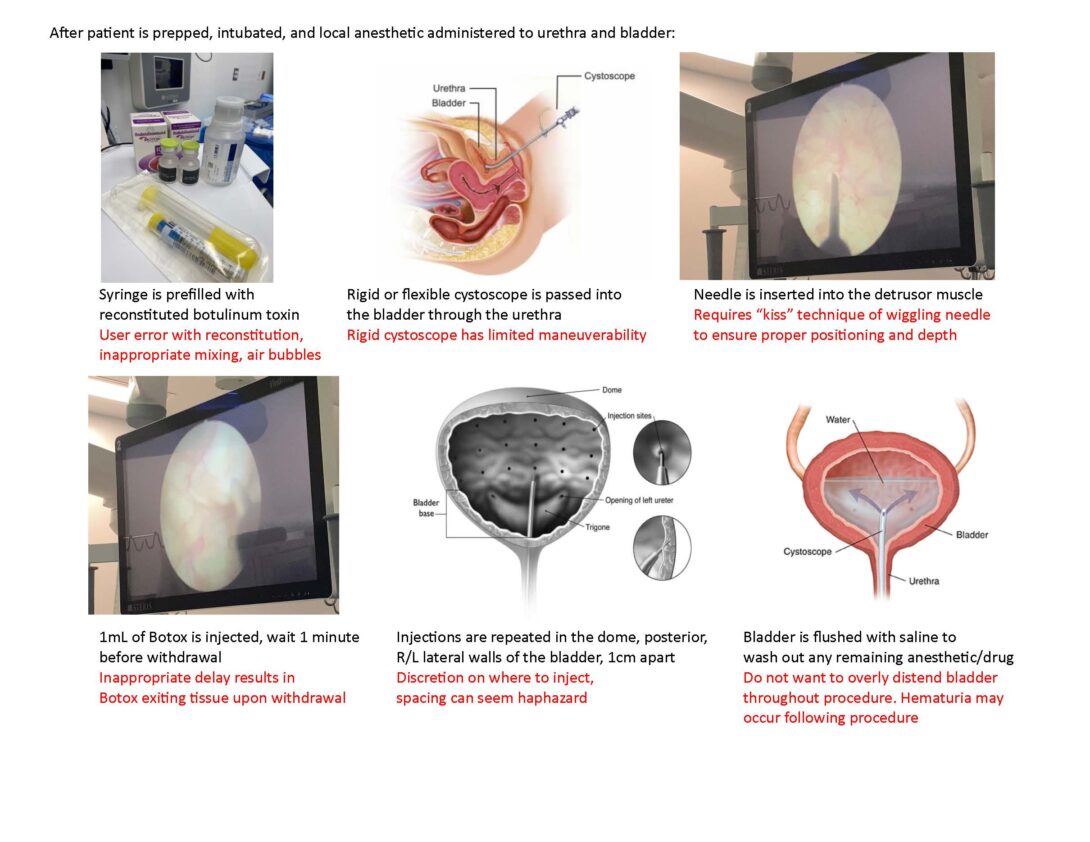
Cadence Lee
Medical Student
Email:
Storyboard: Cystourethroscopy with botulinum toxin injection Heading link

Cystourethroscopy with botulinum toxin injection.
In this review, the authors evaluate randomized controlled trials of botulinum toxin A injection for idiopathic or neurogenic detrusor overactivity and summarize the mechanism of action of the drug intervention. Botulinum toxin acts by blunting central sensitization, inhibiting vesicular release of neurotransmitters and axonal expression of capsaicin and purinoceptors in the suburothelium. This is used for treatment of overactive bladder and urgency incontinence. The authors evaluated randomized controlled studies for injection method, continence, maximum cystometric capacity (MCC), urinary retention, and duration of benefit and found improvements in urinary incontinence episodes, MCC, and maximum detrusor pressure in experimental groups compared to control groups. The duration of relief appeared to be dose-dependent, with longest duration following 200-300 units of injection. The American Urological Association and European Association of Urology support the use of intravesical botulinum toxin injection for patients with urgency urinary incontinence refractory to antimuscarinic therapy.
Though this is a widely accepted intervention, there remain pain points in numerous steps of the procedure, outlined in the storyboard here.
Need statement: urine collection Heading link
Iteration 1: Patients with suspicion of pyelonephritis need detailed instructions on proper urine collection to reduce false positives
Population: patients with suspicion of pyelonephritis
Opportunity: instruction of proper urine collection technique
Outcome: reduce false positives
*Rationale: observed patient in clinic who was giving their 3rd urine sample within 2 weeks, resident did not believe prior results of infection and wanted to repeat. When instructing patient on urine collection, patient did not seem aware of many necessary steps to reduce contamination (wipe tip of penis, catch mid-stream, do not overflow, do not touch inside of cup)
Iteration 2: Patients providing urine sample need detailed instructions on proper clean-catch technique to reduce contamination
Population: patients providing urine sample
Opportunity: instruction of clean-catch technique
Outcome: reduce contamination
*Rationale: scope of relevant population increased to all patients providing urine sample, not just patients with suspicion of pyelonephritis. Opportunity specified to clean-catch technique, which in the literature is described as the best of 4 techniques for reducing contamination
Iteration 3: Urological providers need to ensure clean-catch technique and reduce contamination of urine samples to reduce unnecessary repeat urine collections
Population: urological providers
Opportunity: instruction of clean-catch technique to reduce contamination
Outcome: reduce repeat urine collection and associated inefficiencies (cost, time, resources)
*Rationale: population changed to urological providers to be more direct about the need of providing instruction of clean-catch technique
Investigating Patents: Urine Collection Devices Heading link
Patent #: US6299606B1
“A urine collection device for women has a bowl with sides that bow inwardly to provide a comfortable fit while minimizing spillage. The bowl has an aperture through which urine can pass to a removable specimen jar. An elongated handle extends from the front of the bowl, and is provided with fingergrips on its bottom edge. The device can be molded from plastic, permitting it to be sanitized and reused.”
Application granted: 2001-10-09
Expiration: 2019-03-16
The main claims of this patent describe a sloping bowl with an aperture and handle with ability to attach a collection vessel, suited for female urine collection. Additional claims outline the dimensions, angles, and shape of the bowl. While this is a suitable invention to allow ease of urine collection for female patients, my original intention was to find a device that minimizes user error in the process of clean-catch collection. Therefore, I turned to another lead:
Patent #: US9155525B2
“A urine sample collection device having a collection vessel for capturing urine from a patient, and an associated sample collection container portion for gathering the urine sample in an assured manner without the need for manual transfer. The urine sample collection device can be easily mounted inside a toilet bowl, so that the patient can deliver the urine stream to the toilet in the normal manner to produce the urine sample. The device avoids splashes of residual urine after the sample container is remove from the collection vessel, and a urine flow barrier shield for automatically accommodating the clean-catch method for delivering a urine sample.”
Application granted: 2015-10-13
Anticipated expiration: 2033-03-15
The main claim in this patent outlines a collection vessel fitting into the standard toilet, which has an automatically removed urine flow barrier shield to emulate the process of a clean-catch sample. This system is designed to void the bacteria-containing initial urine flow via the flow barrier shield, and collect the mid-stream urine in a collection vessel. It is also designed to reduce user error, as it attempts to follow the normal urination process in a standard toilet. This is an intriguing solution to last week’s NS, and seems to circumvent other devices that claim clean-catch ability, yet contain flaws in contamination and flow collection. Data on comparison of epithelial cell and mixed growth contamination is needed.